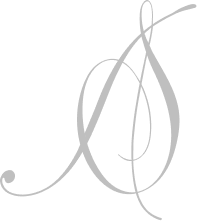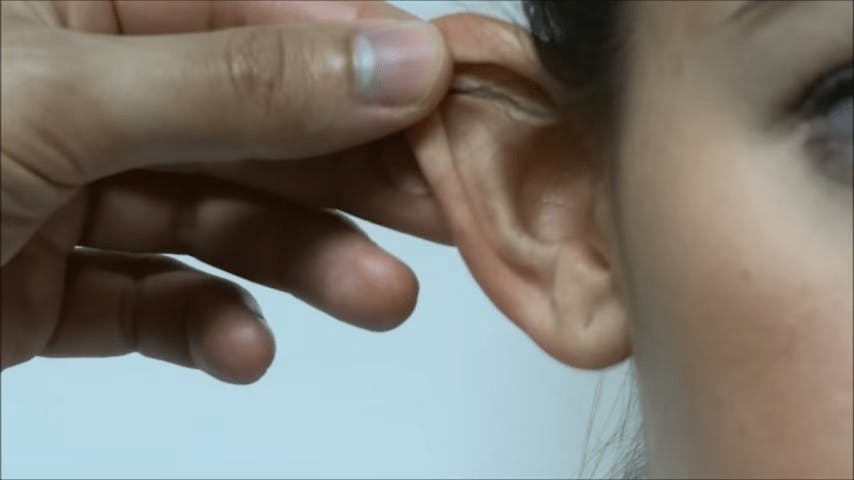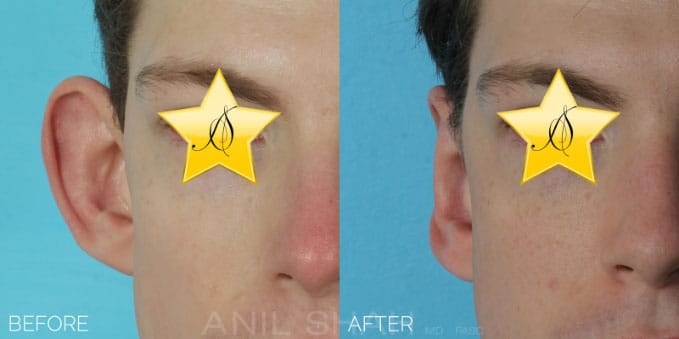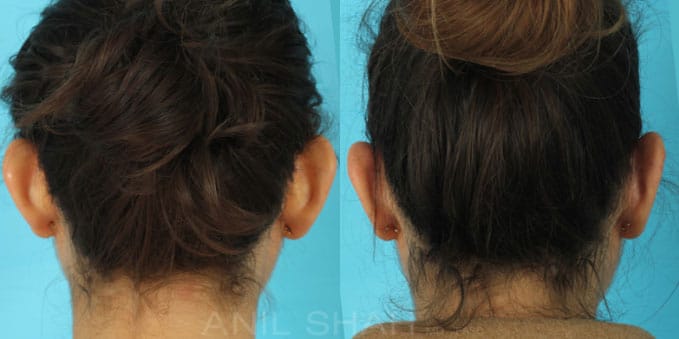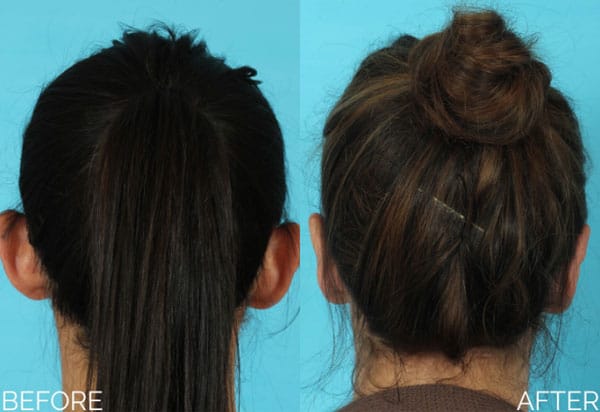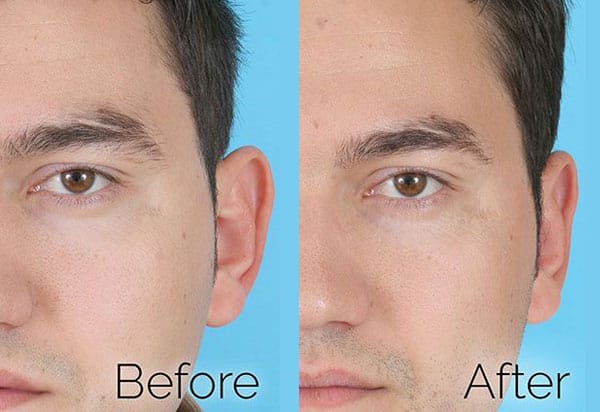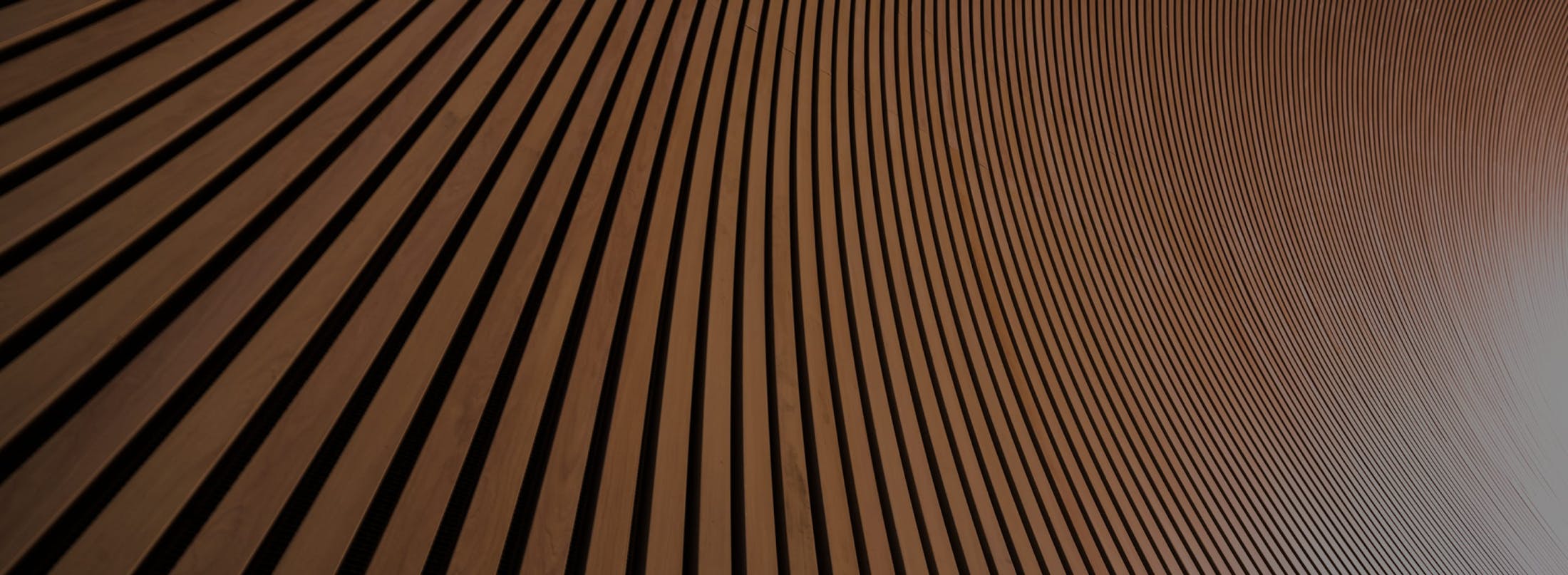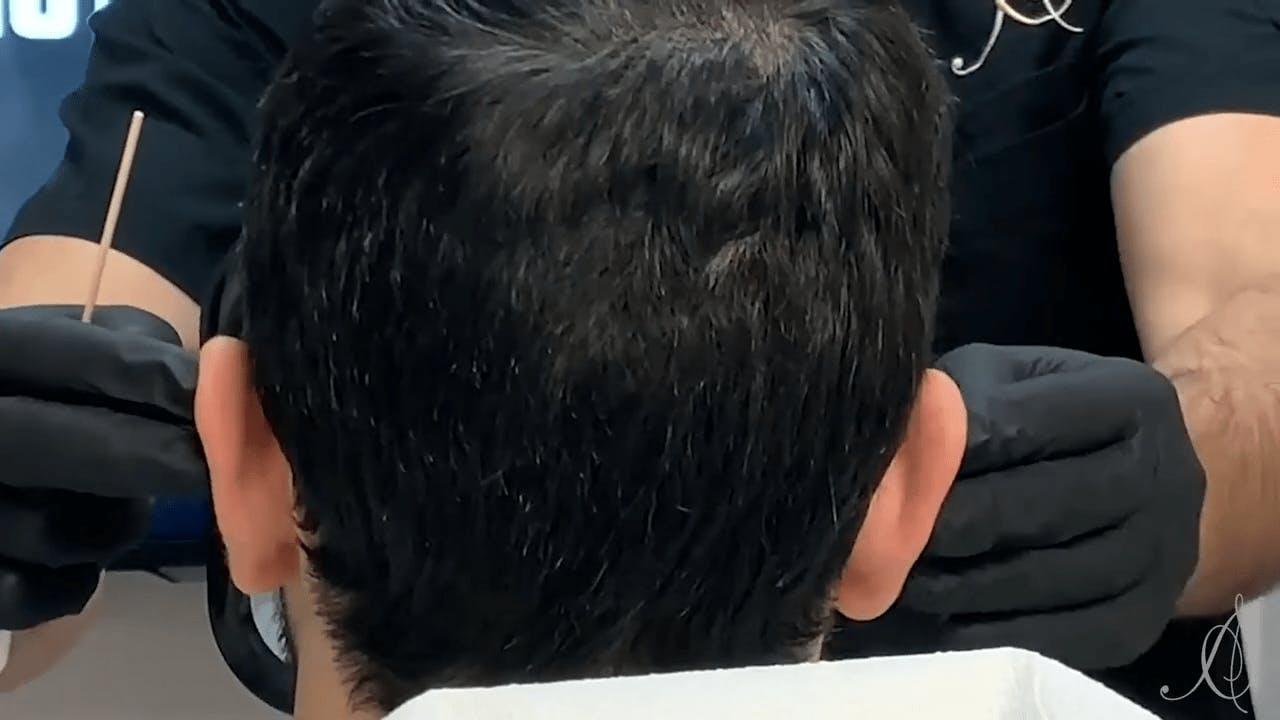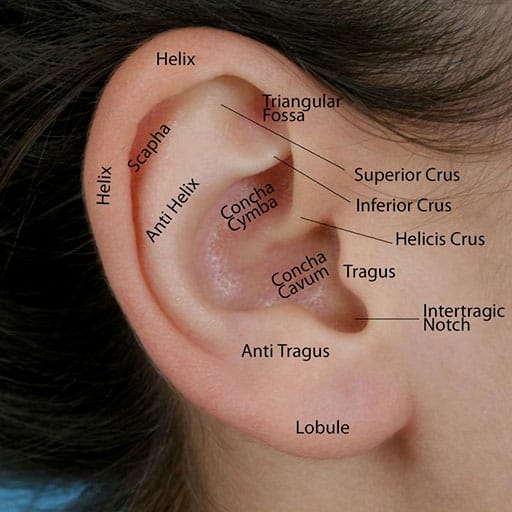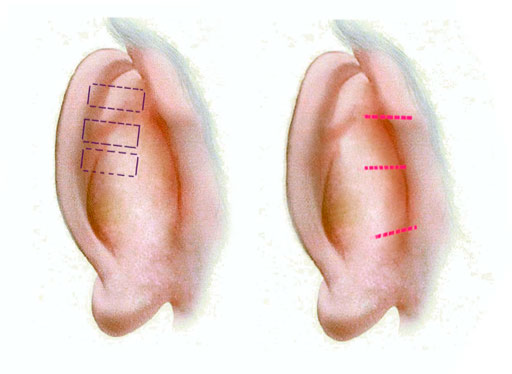Does otoplasty affect my hearing?
Otoplasty will not change hearing in either a positive or negative manner. The mechanism for hearing takes place in the middle and inner ear.
How much do otoplasties cost?
Otoplasty costs depend on several factors including the type of reshaping, the type of anesthesia, and the anticipated length of time surgery will take. In general, otoplasty with light sedation will cost significantly less than otoplasty requiring general anesthesia. As with any plastic surgery procedure, price should not be the reason for picking a surgeon.
What is a pixie ear and does Dr. Shah fix this?
Pixie ear repair can range from a simple office procedure to a need for a redo facelift. Most pixie ears are a result of excessive tension placed on the earlobes, causing them to stretch inferiorly after a facelift settles. An experienced surgeon can advise the best course of action to fix a Pixie ear in the least invasive and most effective manner.
How does Dr. Shah create symmetry for ears?
One of the biggest challenges of otoplasty is creating symmetry post procedure. Dr. Shah performs precise caliper measurements of the superior, middle, and inferior portion of the ear both pre procedure and post procedure allow the surgeon an objective means of adjusting the degree of “pinning” the ears back. Dr. Shah will create symmetry by using measures as well as understanding the healing course that takes place during otoplasty.
Can I wear a pony tail after an otoplasty?
This is perhaps one of the bigger concerns after an otoplasty. Many patients wear hair in a manner to conceal the size of their ears, and post procedure plan on having their ears on full display. A poorly executed scar can take away any benefit from an otoplasty. Dr. Shah uses precise and meticulous closure with close follow up which leads to scars which are difficult to see.
Can earlobes be reduced?
Earlobe reduction requests have become increasingly popular over the last several years. An elongated earlobe can signify aging. Ear lobes can be reduced in the office comfortably under local anesthesia.
Does insurance cover earlobe repair?
Typically, most insurance companies do not cover changes that are due to appearance with the exception of traumatic repair which is medically necessary. Torn ear lobes do not fall into that category. Ear lobe piercing repair for slightly larger ear piercing may or may not require repair. Factors which must be accounted for are:
Are otoplasty scars large or visible?
Unfortunately, poor scarring after an otoplasty is not an unusual thing to see in with many surgeons. This can be a big factor in your ability to wear hair short or pulled back in a ponytail. Dr. Shah closes your scar meticulously and without tension to minimize the occurrence of this. Some steps such as kenalog injections or silicone sheeting can be helpful in select cases as well.
What is the recovery from an otoplasty?
There are various phases during the recovery process of a well executed otoplasty performed by a surgeon with expertise in ear reshaping:
- First 24 hours- Patient wears a mild compressive garment on the head. Patient ear appear larger and more swollen than ideal
- 24 to 72 hours- Patient wears headband over ears as much as possible. Majority of swelling begins to dissipate
- 72 hours to First Week- Some patients will be able to return to work depending on their hairstyle and comfort with swelling in ear and duties at work
- First Week to Second Week- Most patients feel comfortable in social situations with ears
- Three Months-Swelling Completely subsided
- Size of earlobe (smaller earlobes have limited real estate and removal and closure of hole may lead to even smaller lobes post procedure)
- Size of ear piercing site
- Age of patient
- Propensity for keloids or hypertrophic scars
- Repair of ear lobe piercings can be a highly rewarding procedure for patient and surgeon alike, so that patients can now wear earrings with confidence.
Will my ears continue to grow after surgery?
Ears stop growing at around the age of 5 or 6. Ears will lose elasticity over time making them appear longer. However, these changes occur over a long period of time. The changes that occur after an otoplasty are permanent.
What percentage of the population has prominent ears?
Nearly 5% of the population has prominent ears. Most causes of prominent ears are inherited.
What is a cup ear deformity?
A cup ear is where the concha of the ear is overdeveloped causing the ear to cup out.
What is a lop ear deformity?
A lop ear is where the top of the ear lacks an antihelical fold, causing the top portion of the ear to be more prominent.
What is the difference between cartilage splitting and cartilage sparing techniques?
Cartilage splitting techniques refers to techniques which excise cartilage. Cartilage sparing techniques refer to those techniques which spare the cartilage, most typically using sutures to reshape the ear. Dr. Shah uses a tailored approach to reshaping the ear to provide a natural contour change to the ear. He bases his technique on the individual anatomy of the patient.
Should I have my ears reduced?
Otoplasty is an individual choice as is plastic surgery.
What are some medical reasons for me not to have an otoplasty?
There are few medical contraindications to an otoplasty. Patients with a history of chondritis and chronic draining ear infections are not ideal candidates. Patients with a history of keloid or hypertrophic scars should be aware that there is a possibility for keloid formation post procedure and need for kenalog injections.
Can otoplasty affect my hearing?
The ear hears through sound passing through the external auditory canal, hitting the tympanic membrane and ossicles and finally reaching the cochlea before traveling to the brain. Any impedance along the way can affect hearing. It is extremely uncommon for an otoplasty to affect hearing. In patients with setback sutures, if the surgeon places the suture too close to the external auditory canal, a narrowing of the canal can occur, which could potentially affect hearing.
What is a Darwinian tubercle?
A Darwinian tubercle is a portion of the ear thickened near the superior and middle pole of the ear. see picture (get sam shah ear). Darwinian tubercles are common variants of a normal ear seen in approximately 10% of the population. In some patients, the size, shape, or asymmetric nature of a Darwinian tubercle can be a source of frustration. Decreasing the tubercle can be accomplished at the same time as an otoplasty by shaving down the helix. In cases of isolated Darwinian tubercle issues or with large tubercles, an anterior approach can be utilized.
How does Dr. Shah address the prominent lower ear (i.e. the ear lobule, lower portion of concha, etc)?
The lower portion of the ear is addressed by finding the root cause of the prominence. In patients with prominent ear lobes, an earlobe reduction or pexy can be performed. If there is excess cartilage in the area, the lower part of the helical cartilage (caudal aspect) can conservatively trimmed as can the conchal bowl.
What is a telephone deformity of the ear?
This is where the surgeon aggressively sets back the middle of the ear in relation to the upper and lower portion of the ears. This creates the appearance of a telephone. Dr. Shah fixes patients with poor otoplasty outcomes by defining what is the main issue with the ear. Most commonly, failure to adequately correct the superior and lower pole has created a telephone deformity to balance the appearance of the ear.
What is reverse telephone deformity?
In this case, the superior and lower poles are too close to the head in relation to the middle portion. This may result in either releasing setback sutures or reducing the size and shape of the conchal bowl.
What makes ear look prominent?
There are two factors which can make an ear look prominent. First of all, there is ear projection or how far the ear sticks out from the head. The further the ear sticks out from the head, the more attention it will draw to itself. The other factor which makes ears look prominent is the relative size of the ears to the other facial structures and the head. Size is typically measured from the top of the ear to the ear lobe. In otoplasty, projection and size are addressed by a variety of ear maneuvers to bring the ear closer to the head and actually decrease the surface of the ear depending on the case.
Does the head need to be shaved for otoplasty?
No, even in long haired patients the incision is made behind the ear in the post auricular crease.
How far should your ears stick out from your face?
The ear is typically measured in three locations, the top of the ear, the middle, and the bottom of the ear in relationship to the bony portion behind the ear called the mastoid. Normally, the ear protrudes about 11 mm from the top of the ear, 17 mm from the middle third, and 21 mm along the lower portion. The concha (or bowl of the ear) is typically 14 mm from the mastoid of the ear. Another way to analyze the ears is to measure the helix and the mastoid should be about 20 degrees. In patients with prominent ears, the ears will protrude at least 30 degrees.
How big should my ears be?
The length of the ears are typically 6 cm while the width of the ear is around 3.5 cm
What type of suture does Dr. Shah recommend?
Dr. Shah only recommends the use of permanent sutures which are braided. Non permanent sutures are not as effective in the long term maintenance of the ear and can lead to earlier relapses. Non braided sutures have too much memory and can create unintended cuts through the delicate cartilage of the ear.
Is scoring of the fold essential?
Scoring of the ear is done on a case by case basis depending on an individual’s anatomy.
What are the risks of permanent suture placement?
Any permanent suture may be rejected by the body or extrude.
When can I wear earrings after an earlobe reduction?
Most patients can wear earrings 4 to 6 weeks after the procedure. We don’t recommend the use of heavy earrings.
Will I have a scar to my earlobe?
Scars in the earlobe conceal well.
How much time will my child have to have off school?
Typically about a week. It is best done under a break during the school year. Activity can be slowly increased as the child’s recovery progresses.


